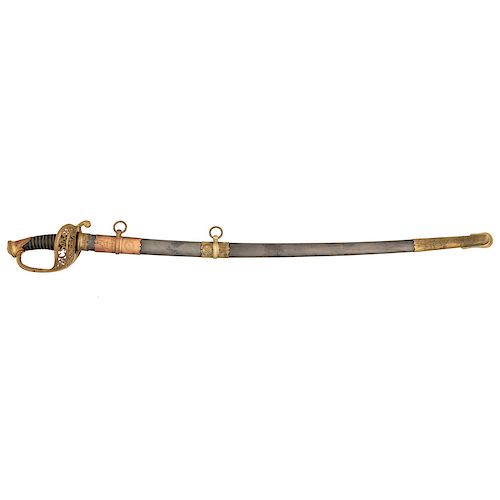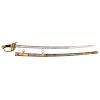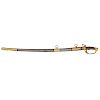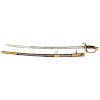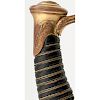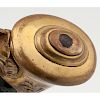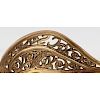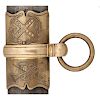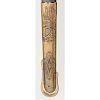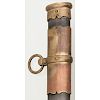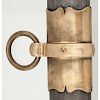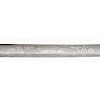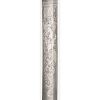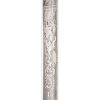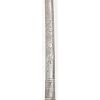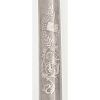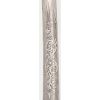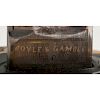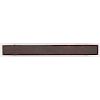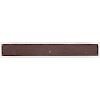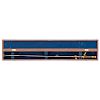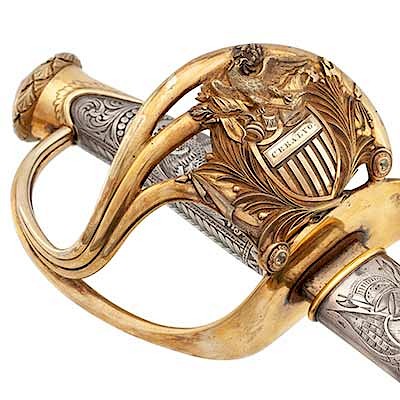Cased Presentation Boyle and Gamble Sword to Major General Mahone
About Seller
6270 Este Ave.
Cincinnati , OH 45232
United States
With offices in Cincinnati, Cleveland and Denver, Cowan’s holds over 40 auctions each year, with annual sales exceeding $16M. We reach buyers around the globe, and take pride in our reputation for integrity, customer service and great results. A full-service house, Cowan’s Auctions specializes in Am...Read more
Two ways to bid:
- Leave a max absentee bid and the platform will bid on your behalf up to your maximum bid during the live auction.
- Bid live during the auction and your bids will be submitted real-time to the auctioneer.
Bid Increments
| Price | Bid Increment |
|---|---|
| $0 | $25 |
| $500 | $50 |
| $1,000 | $100 |
| $2,000 | $250 |
| $5,000 | $500 |
| $10,000 | $1,000 |
| $20,000 | $2,500 |
| $50,000 | $5,000 |
| $100,000 | $10,000 |
About Auction
Oct 30, 2018
Cowan's is honored to present the Magnificent Sword Collection of William Koch in its two-day firearms, militaria, and American history auction, with a focus on the Civil War. Cowan's Auctions dawnie@cowans.com
- Lot Description
Cased Presentation Boyle and Gamble Sword to Major General Mahone
33.5" slightly curved single-edged blade with 26" stopped central fuller. 5.75" gilt brass hilt with open-work guard having the letters CS cast into it. Blade with frosty etching that features flowing martial and foliate themes with a billowing Confederate pennant on the reverse featuring the "Stars and Bars" and with a variation of Virtus, from the state seal of Virginia on the obverse in full war regalia with a Confederate battle flag and curved short sword surmounting the letters CS . The central panel on the reverse is etched in a variety of banners and ribbons: PRESENTED TO MAJOR GENERAL WILLIAM MAHONE BY THE CITIZENS OF PETERSBURG VA IN APPRECIATION OF HIS ENERGY AND GALLANTRY IN DEFENCE OF THEIR CITY DURING THE CAMPAIGN OF 1864 . The reverse ricasso is etched BOYLE & GAMBLE / RICHMOND . Grooved wood grip with leather cover and 14 wraps of gilt triple-strand wire, with the center of the three twisted. Metal scabbard with gilt brass mounts engraved with a variation of the Virginia State Seal, showing Vitus astride the tyrant and sword through a laurel wreath on the upper mount, a St. Andrews Cross surrounded by a wreath a drum/bugle/bayonet on the middle mount and panoply of arms featuring spears and armor on the lower mount. Sword is contained in a period wood case with blue baize lining, brass hinges and brass hook closures. Additionally a bag for the sword, made from sky blue kersey is included. This bag appears to have been made from the leg from a pair of Federal infantry trousers. Overall a simply stunning and eminently historical Confederate presentation saber that is a wonderful example of the quality of work that could be done by firms like Boyle & Gamble even during the death throes of the Confederacy in late 1864.
William Mahone (1826-1895) was the plebeian son of a Southampton County, Virginia tavern keeper who aspired to the Virginia Military Institute and graduated from VMI in 1847. Mahone did not seek out military service, instead taking up the study of civil engineering while teaching at the Rappahannock Military Academy. Mahone's interests were mechanical, meaning the railroads and he soon excelled at challenging engineering tasks for several of the smaller Virginia lines before becoming President and Superintendent of the Norfolk & Petersburg line on the eve of war in 1861. Mahone received accolades for his engineering work and had started the planning phase for an extension of the Norfolk & Petersburg to Bristol, Tennessee with "ultimate objective of extending connections to the Mississippi and to the Pacific coast." With the advent of war, Mahone was appointed colonel of the 6th Virginia Infantry in May 1861and assisted in the capture of the Norfolk Navy Yard which provided the nascent Confederate Navy with a hoard of naval stores. He would command the Norfolk District until being forced to evacuate during the Peninsula Campaign. Mahone was then called upon to put his engineering skills to work supervising the layout of the defenses at Drewey's Bluff and constructing the shore based artillery redoubts that would control access to the James River approach to Richmond. He was duly promoted to brigadier general on October 10, 1861 (dates vary) and put in command of the critical defenses at Drewey's Bluff. Thereafter, Mahone would serve continuously in the field while amassing (compiling) a spectacular record with the Army of Northern Virginia. Following the war, General Lee observed, "that of the surviving younger men in the army Mahone made the largest contribution to organization and command." Mahone led his brigade assigned to Huger's division at Seven Pines where his and Armistead's brigade "struck the enemy a telling blow on the second day." At 2nd Manassas Mahone's brigade, part of Richard Anderson's division in Longstreeet's Corps, conducted themselves "brilliantly" and with "conspicuous gallantry" although General Mahone was seriously wounded, "shot in the chest while leading his brigade in a charge across Chinn Ridge." The wound was serious but thankfully not life threatening preventing him from participating in the Maryland Campaign where his brigade once more distinguished itself "in the valorous defense of the South Mountain passes." Mahone's convalescence lasted a couple of months whereupon he returned to full duty leading his brigade at Fredericksburg but not seeing any action. During the winter of 1862-63 Mahone began pressing the War Department for a major general's commission supported by a body of fellow officers. While tacitly acknowledging the general's exemplary service with the Army of Northern Virginia to date, Lee demurred on Mahone's request, later explaining to him that he would have to wait for a billet to open up. Mahone got on with the war and saw some action at Chancellorville under Longstreet's command. When the Army of Northern Virginia was reorganized in May 1863, into three corps, Mahone's brigade was assigned to A.P. Hills'. Mahone did not participate in any serious fighting at Gettysburg. On July 2, 1863, Mahone had supposedly been instructed by General Hill to join in the attack on Cemetery Ridge but defying the order, held his brigade back claiming that General Anderson had told him to do so. In the aftermath of Gettysburg retreat the alleged act of disobedience was glossed over and Mahone, in part due to his seniority, avoided any long lasting consequences resulting from the "miscommunication." With the strategic situation of the Confederacy becoming perilous, Longstreet's Corps was detached and sent west as reinforcements for the army of Tennessee. The weakened ANV was forced into a temporary defensive posture, Lee's brigades spread thin, his men hunkered down in a line of ever lengthening entrenchments pending a favorable strategic outcome of events in the west. Longstreet's tenure of semi-independent command was cut short as he fortuitously rejoined the Army of Northern Virginia just in the nick of time to counter the Grant's initial attack in the Wilderness on May 6, with a powerful flanking attack along the Orange pike road that nearly enveloped and destroyed the Federal 2nd corps. During the fighting Mahone's men accidentally wounded Longstreet - "a bullet passed through his shoulder causing nerve damage" - and he would not rejoin the army until October with his right arm paralyzed. With Longstreet gone indefinitely, Lee appointed Richard Anderson to take over the corps of his trusted subordinate. This finally opened up a major-general's billet, in Anderson's division, in which Brigadier General William Mahone succeeded to command as temporary major general (a commission he rejected). Mahone led the division at Spotsylvania Court House and became an overnight hero at the battle of the Crater on July 30 1864. Several waves of Union infantry assaults having been already repulsed with heavy casualties, Union miners were enlisted to dig a tunnel beneath the Confederate strongpoint, planting "320 kegs of powder" that would be ignited to blow it up and, this time, allow another coordinated union infantry assault to penetrate and overwhelm the stunned Confederate defenders. The massive explosion went off according to plan killing and wounding a number Confederates mostly in two regiments, the blast and concussion causing the hoped for confusion and disorder. However, the follow-on Union attack was a complete disaster. Grant later wrote that the assault was "the saddest affair I have ever witnessed in this war." Following the explosion the first troops into the crater, men of the 9th Corps commanded by General Hooker, milled about, all cohesion and momentum lost. The tables quickly turned as the Federals were then forced to take refuge in the Crater as a determined counterattack led by Mahone's division rallied the dazed confederate defenders. Mahone brought up artillery in support to the very edge of the Crater as every Southern musket tore into the huddled mass of Yankees below. Burnside compounded the slaughter by ordering General Ferraro's division of black troops into the Crater where, completely outflanked, many were subsequently murdered after surrendering, adding the taint of war crimes to the calamity. The battle of the Crater ended after more of Mahone's troops "conducted a sweep out of a sunken gully area about 200 yards from the right side of the Union advance into the Crater." Mahone's charge reclaimed the badly damaged earthworks and drove the disorganized Federals out of the depression at the point of the bayonet back towards the east. Mahone had demonstrated his mettle - the quick and decisive action was a rare cause for celebration by the occupants of Petersburg and its embattled citizens - and on June 30, 1864 (another source cites July 20) Mahone was advanced to major general. Of tremendous significance to General Mahone later in the war would be award of this singular "work of art" sword "presented by the grateful citizens of Petersburg, his wife and children were residing there. In "Appreciation of "HIS SKILL ENERGY AND GALLANTRY IN DEFENSE OF THIER CITY..." on Wednesday March 22, 1865, the Richmond Daily Dispatch reported the presentation of a "sword, belt, and sash to Major General William Mahone by the citizens of Petersburg." The presentation, the paper reported, "took place in the presence of a large assemblage of officers, soldiers, citizens and ladies, who gathered together to witness the pleasant event." Author Donald Tharpe in a speech before the American Arms Collector's Society wrote, "Those embattled witnesses of Petersburg, a city, under siege for ten months, would likely see little else that was pleasing in the next several weeks." On March 25, 1865, just two days later, the final campaign of the Army of the Northern Virginia began when Gen. Lee attempted to break Gen. Grant's tightening death grip on Petersburg by taking the Federal-held Fort Stedman, just east of the city. They initially met with success, but the relentless Federals retook the fort. The Confederates ultimately lost the strategic position as well as the lives of 3,500 of their already tragically depleted troops." Petersburg and Richmond would fall on April 2, and a week later on April 9 the remnants of the Army of Northern Virginia would finally surrender at Appomattox. Major General Mahone surrendered his division with the last of the butternut ghost-army at Appomattox and years later composed a concise remembrance of the events - "what I saw and heard" - during the last few days of the war in company with General Lee. Lee had intoned to "those survivors of so many hard fought battles" to now go home and rebuild in his brilliantly worded farewell address to the army. Mahone did as ordered, setting about the task of rebuilding the devastated railroads of war-torn Virginia and by 1867 had become president of three, and weighing grand plans for future linkage and expansion. The Mahones moved back to Petersburg in 1872. The Financial Panic of 1873 put a halt to Mahone's successes when he was ousted from the role of receiver for the A M & O Railroad, although he fought to regain control. In 1881, a consortium of Philadelphia based businessmen purchased the line at auction, outbidding Mahone's backers and renaming it the Norfolk and Western. Mahone then delved into politics and thanks to his military notoriety quickly mobilized a strong base of support. He was beaten in his first try for governor in 1877, but was elected to the US Senate in 1880 on the "Readjuster ticket, a re-branded coalition of the Republican Party whose broad platform including restructuring the state's pre-war debt while improving infrastructure and increased funding for schooling, particularly for blacks. Mahone held off challenges from the opposition Conservative Party, the Democrats, but after Grover Cleveland, a democrat, became President in 1884, Virginia fell in line with the national directive of the party. Mahone was a presidential elector at both the 1884 and 1888 National Republican convention, but had lost his senate seat to a democrat in 1886. Virginia politics slipped away. He made one last try for the governorship in 1889 but lost the election. Mahone still remained active in state politics until suffering a debilitating stroke in early October 1895 while in Washington, D.C. The aging fighter lingered for a week before finally dying on October 8, 1895, age 68. Major General William Mahone was buried in the family mausoleum marked with a simple "M" in Blandford Cemetery, Petersburg Virginia, where the pinnacle of his service to the South was once recognized on a presentation sword from grateful citizens thirty-one years before.
Provenance: From the Sword Collection of William KochVery fine. Blade with most of the original frosty etching and bright polish, showing only the most minor thinning and loss and some minute surface freckling. Hilt with traces of gilt and a lovely rich patina, wrap fine with some light handling marks. Scabbard about fine with traces of finish on the metal and mounts. Scabbard body with some scattered oxidation, freckling and light pinpricking. Case very good. Wool bag worn with loss.Condition
- Shipping Info
-
Buyers are required to pay for all packing, shipping and insurance charges. Overseas duty charges are the responsibility of the successful Bidder. Be aware that for larger and/or valuable items, shipping charges can be substantial. - If there is no shipping amount on listed your invoice, you will need to make arrangements to pick up or ship your purchase through an alternative shipping company. Our shipping department can be contacted at 513.871.1670 (ext. 219) or email shipping@cowans.com. - Shipping charges include insurance for your order while in transit. If you have private insurance we will adjust your charge to include only packing and shipping. - Please allow 14 – 21 days after payment to package and ship your purchase as carefully as possible.
-
- Buyer's Premium



 EUR
EUR CAD
CAD AUD
AUD GBP
GBP MXN
MXN HKD
HKD CNY
CNY MYR
MYR SEK
SEK SGD
SGD CHF
CHF THB
THB